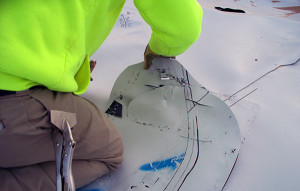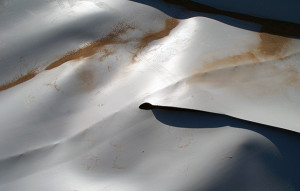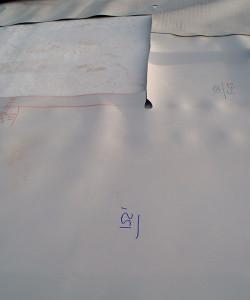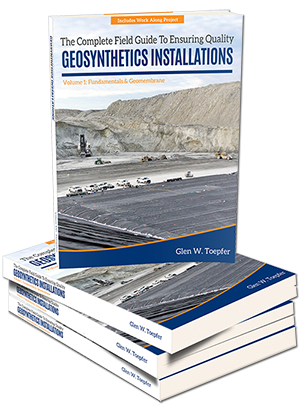While attending the 2014 Geosynthetics Mining Solutions Conference, several interesting points were made on which I would like to continue discussion.
Some of these topics aligned with the way I was trained and some offered new ways to look at things. I always find it fascinating to observe and learn of different viewpoints, and so I am really interested to see what anyone has to say on the following three topics:

Image 2: Cutting out intersection and air test tabs to assure all damage is rounded edges below the repair
Topic #1: Slope destructs, where should they be taken?
Let’s assume that you are on a geomembrane containment project and destructs will be required to be taken on these slope seams. Let’s also assume beyond (outside) the slope crest, the grade is relatively flat to the anchor trench (1% or less) and assume the crest is 5′ from the inside (slope side) edge of the anchor trench.
Where do you take destructs at? What factors play into your consideration? Material type? Slope grade? Does the type of weld matter? What about suspect areas? Are these issues commonly addressed in your site specifications?
Topic #2: Damage termination
For some repairs, such as a wrinkle cut out, it is recommended that the damage be terminated with a “circle-cut” or a “keyhole cut”–basically rounding the edge of the damage to minimize the damage continuing when stress is induced on the geomembrane (See Image 1).
First of all, how many times do you see this done by an installer without having to tell them? How many of you have heard the term “fishmouth” pertaining to geomembrane welding? How many have seen a geomembrane “fishmouth”? What is the proper way to fix a “fishmouth”?
Back to the rounded cut during repair preparation—should this methodology be applied to all cuts made in the geomembrane (such as those in Image 2 and Image 3)? After all, a cut for an air test will also have a straight edge that could be point of yield or failure under stress (such as in Image 2). Likewise, what about cuts made for other repairs, such as burnouts, stone removals, and destructs–should the rounded approach also apply to these? Or does it matter, because after all, the damage is repaired, most likely with an extrusion patch or cap over the area. Are these issues commonly addressed in your site specifications?
Topic #3: Scratch depth
Does anyone even bother to look for or repair scratches anymore, given the vast improvement in geosynthetics material? If so, what is the depth that constitutes concern for you (% of parent material thickness)? How do you measure depth of a scratch? As many installers point out, are your really doing more damage by repairing a scratch than leaving it alone? If so, is that true of all depths, or only up to a certain depth? How often do you see scratches addressed in site specifications?
As always, I look forward to hearing from you on these interesting and equally important topics!





